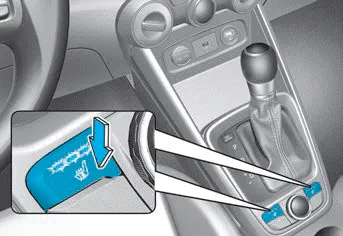Hyundai Venue (QX): Seats / Seat Warmers
Seat warmers are provided to warm the seats during cold weather.
WARNING
The seat warmers can cause a SERIOUS BURN, even at low temperatures and especially if used for long periods of time.
Passengers must be able to feel if the seat is becoming too warm so they can turn it off, if needed.
People who cannot detect temperature change or pain to the skin should use extreme caution, especially the following types of passengers:
- Infants, children, elderly or disabled persons, or hospital outpatients.
- People with sensitive skin or who burn easily.
- Fatigued individuals.
- Intoxicated individuals.
- People taking medication that can cause drowsiness or sleepiness.
WARNING
NEVER place anything on the seat that insulates against heat when the seat warmer is in operation, such as a blanket or seat cushion. This may cause the seat warmer to overheat, causing a burn or damage to the seat.
NOTICE
To prevent damage to the seat warmers and seats:
- Never use a solvent such as paint thinner, benzene, alcohol or gasoline to clean the seats.
- Do not place heavy or sharp objects on seats equipped with seat warmers.
- Do not change the seat cover. It may damage the seat warmer.

While the engine is running, push either of the switches to warm the driver’s seat or front passenger’s seat.
During mild weather or under conditions where the operation of the seat warmer is not needed, keep the switches in the OFF position.
- Each time you push the switch, the temperature setting of the seat is changed
as follows:

- When pressing the switch for more than 1.5 seconds with the seat warmer operating, the seat warmer will turn OFF.
- The seat warmer defaults to the OFF position each time the ignition switch is turned to the ON position.
The rear seats are equipped with head restraints in all the seating positions for the passenger’s safety and comfort. CAUTION For each rear passenger, adjust the head restraint so that the middle of the head restraint is at the same height as the height of the top of the eyes.
This section describes how to use the seat belts properly. It also describes some of the things to avoid when using seat belts.
Other information:
Hyundai Venue (QX) (2020-2025) Service Manual: Evaporator Core. Repair procedures
Replacement 1. Disconnect the negative (-) battery terminal. 2. Remove the heater unit assembly. (Refer to Heater - "Heater Unit") 3. Separate the evaporator temperature sensor connector (A), loosen the mounting screws and remove the eva
Hyundai Venue (QX) (2020-2025) Service Manual: Description and operation
Description and Operation Blcok Diagram • This system monitors the driving situations through the radar and the camera. Thus, for a situation out of the sensing range, the system may not normally operate.
Categories
- Manuals Home
- Hyundai Venue Owners Manual
- Hyundai Venue Service Manual
- Repair procedures
- Engine Control / Fuel System
- Advanced Driver Assistance System (ADAS)
- New on site
- Most important about car
